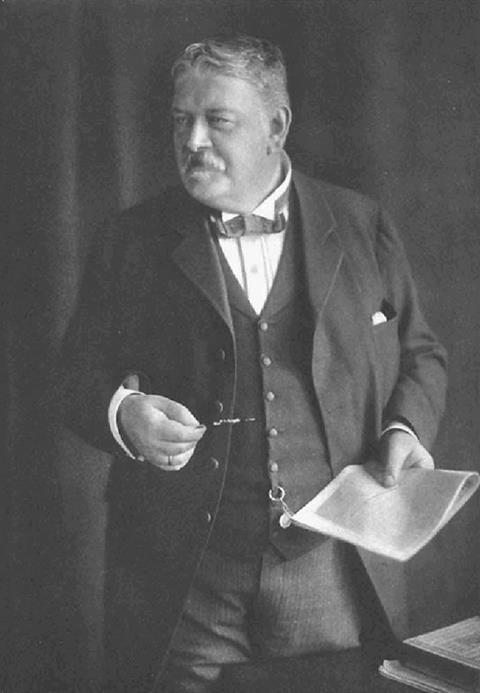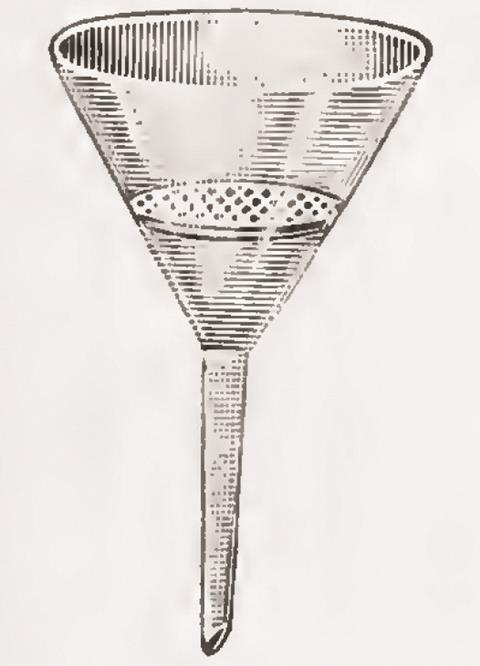The chemist caught in the 19th century battle for colour
Otto Nikolaus Witt
Russian–German chemist (1853–1915). Originator of chromophore–auxochromo theory of dyeing
Today, we are greeted by a riot of colour on entering almost any clothes shop. In the UK, we often remember and celebrate William Henry Perkin for introducing mauveine, the first aniline dye. But the dye industry is a good example of how an industry that began in the UK, lost its way, and came to be dominated by another country entirely: Germany. And among the key players was a man who helped solve the problems of how to isolate a precipitate.
Otto Witt was born in Saint Petersburg, Russia, the son of a German pharmacy professor. He was still in school when the family moved again, this time to Switzerland, and he went on to study chemical technology at the Federal Polytechnic School in Zurich. Finishing his degree in 1873, Witt found a job in a steelworks in Duisburg, Germany. But he was restless, and within months was back in Zurich making colours for cotton printers.
Dyeing had never been more exciting. Although the discovery of mauveine by Perkin 20 years earlier had been met with scepticism by Perkin’s supervisor August Hofmann (Chemistry World, January 2010, p68), it was soon followed by the discovery of other brightly coloured compounds obtained by the oxidation of mixtures of anilines. The new colours began to revolutionise the textile industry. In 1858, the flamboyant graduate student Peter Griess, working in Hermann Kolbe’s lab at the University of Marburg, discovered the diazotisation reaction when he warmed anilines with nitrous acid.
Griess’s discovery opened up the possibility of coupling together the burgeoning range of aromatic molecules that were being discovered across Europe. Griess joined Hofmann’s group in London, where he continued to study his coupling reaction. Around the same time, Heinrich Caro and Carl Martius (a student of Hofmann’s), working with their employer John Dale in Manchester, developed the first two azo dyes: Manchester Yellow and Bismarck Brown.
Developments in the dyeing industry were so interesting that Witt went back to university, this time working at least in part in Victor Meyer’s lab (Chemistry World, February 2012, p60). Here, he began to unpick the nature of a series of coloured mercapto dyes that were being used in France. His thesis in 1875 reported on the reactions of aromatic nitrosamines and their reactions with dichlorobenzene. With this unusual combination of fundamental chemistry and applied technology he quickly found a job: on Caro’s recommendation, he joined Williams, Thomas & Dower in west London.
Witt was given a free rein to experiment and immediately focused on azo dyes, puzzling over what determined their colour. In a crucial paper published in 1876, Witt speculated that coloured compounds were the result of a consistent grouping of atoms – he called it a chromophore – whose properties were modulated by changing the structure of the aromatic groups around it – the chromogens. By adding a charged unit, the auxochrome, the dye could be made to stick to a fabric.
This was a huge conceptual leap. By deliberately changing the number of amino groups on an aromatic framework, Witt obtained an orange compound that sat neatly between the previous known reds and yellows. He named it chrysoidine and by making further substitutions obtained a class of yellows – tropaeolins – that provided a vast range of tonality.
In spite of this success, Witt tired of working in London: like many of his German contemporaries, he felt that British industrialists were reluctant to take up innovations. Caro and Martius had already returned to Germany to join firms that would eventually become giants in the field, BASF and Agfa. It was the right move. Griess, who had moved from Hofmann’s lab to work as a chemist with a brewer in Midlands, would patent his continuing dye research with Caro’s BASF rather than with his own employer who just wasn’t interested. The result was that German firms like BASF, Agfa, Hoechst and Baeyer steadily undercut British industry in both price and quality.
Witt returned to Germany and worked for a series of different dye companies before concluding that he was more interested in the science than in the day-to-day problems of the factory. He moved to the Technical University of Berlin, where he gained his habilitation in 1886. The basement lab he inherited was a mess. He set to work with the help of the previous occupant’s lab technician, clearing the lab and equipping it with apparatus. Like so many of his time he was an exceptional glassblower while his lab technician, an excellent mechanic, built the rest.
Witt was at home in the lab, as evidenced by a short paper he submitted in 1886 describing an improved method for vacuum filtration. Vacuum filtration in a normal conical filter funnel could not be done with conventional paper; instead, Robert Bunsen had proposed the use of little sieves made of platinum or pumice that would sit in the funnel and catch the precipitate (Chemistry World, February 2008, p67). Witt suggested placing a disc made of glass, porcelain or the purest nickel (platinum was too expensive), riddled with holes, into the funnel. Onto this plate would be laid two sheets of long-fibre filter paper, moistened to provide a good seal. The product could then be filtered, washed and recovered with ease. Witt’s system worked, but it required real care to use – the plates leaked round the sides and could slip sideways, dumping the precipitate into the filtrate. The instrument maker Martini and Kaehler quickly began marketing plates equipped a rubber O-ring and a long ‘tail’ to locate the place in the funnel.
Almost immediately the method was improved. Robert Hirsch (Chemistry World, March 2009, p66), and Ernst Büchner (Chemistry World, November 2009, p72) developed their now eponymous filters in which the plate is integrated into the funnel itself. Witt – and his innovation – was largely forgotten. And yet he had the last laugh: Witt’s idea of the chromophore has given us the myriad colours, tones and hues that brighten every moment of our lives.
Enter any shop and you are greeted by a riot of colour. In the UK, we often remember and celebrate William Henry Perkin for introducing mauveine, the first aniline dye. But the dye industry is a good example of how an industry that began in the UK, lost its way, and came to be dominated by another country entirely: Germany. And among the key players was a man who helped solve the problems of how to isolate a precipitate.
Otto Witt was born in Saint Petersburg, Russia, the son of a German pharmacy professor. He was still in school when the family moved again, this time to Switzerland, and he went on to study chemical technology at the Federal Polytechnic School in Zurich. Finishing his degree in 1873, Witt found a job in a steelworks in Duisburg, Germany. But he was restless, and within months was back in Zurich making colours for cotton printers.
Dyeing had never been more exciting. Although the discovery of mauveine by Perkin 20 years earlier had been met with scepticism by Perkin’s supervisor August Hofmann, it was soon followed by the discovery of other brightly coloured compounds obtained by the oxidation of mixtures of anilines. The new colours began to revolutionise the textile industry. In 1858, the flamboyant graduate student Peter Griess, working in Hermann Kolbe’s lab at the University of Marburg, discovered the diazotisation reaction when he warmed anilines with nitrous acid.

Griess’s discovery opened up the possibility of coupling together the burgeoning range of aromatic molecules that were being discovered across Europe. Griess joined Hofmann’s group in London, where he continued to study his coupling reaction. Around the same time, Heinrich Caro and Carl Martius (a student of Hofmann’s), working with their employer John Dale in Manchester, developed the first two azo dyes: Manchester Yellow and Bismarck Brown.
Developments in the dyeing industry were so interesting that Witt went back to university, this time working at least in part in Victor Meyer’s lab. Here, he began to unpick the nature of a series of coloured mercapto dyes that were being used in France. His thesis in 1875 reported on the reactions of aromatic nitrosamines and their reactions with dichlorobenzene. With this unusual combination of fundamental chemistry and applied technology he quickly found a job: on Caro’s recommendation, he joined Williams, Thomas & Dower in west London.
Witt was given a free rein to experiment and immediately focused on azo dyes, puzzling over what determined their colour. In a crucial paper published in 1876, Witt speculated that coloured compounds were the result of a consistent grouping of atoms – he called it a chromophore – whose properties were modulated by changing the structure of the aromatic groups around it – the chromogens. By adding a charged unit, the auxochrome, the dye could be made to stick to a fabric.
This was a huge conceptual leap. By deliberately changing the number of amino groups on an aromatic framework, Witt obtained an orange compound that sat neatly between the previous known reds and yellows. He named it chrysoidine and by making further substitutions obtained a class of yellows – tropaeolins – that provided a vast range of tonality.
In spite of this success, Witt tired of working in London: like many of his German contemporaries, he felt that British industrialists were reluctant to take up innovations. Caro and Martius had already returned to Germany to join firms that would eventually become giants in the field, BASF and Agfa. It was the right move. Griess, who had moved from Hofmann’s lab to work as a chemist with a brewer in Midlands, would patent his continuing dye research with Caro’s BASF rather than with his own employer who just wasn’t interested. The result was that German firms like BASF, Agfa, Hoechst and Baeyer steadily undercut the British in both price and quality. The British dye industry faded.

Witt returned to Germany and worked for a series of different dye companies before concluding that he was more interested in the science than in the day-to-day problems of the factory. He moved to the Technical University of Berlin, where he gained his habilitation in 1886. The basement lab he inherited was a mess. He set to work with the help of the previous occupant’s lab technician, clearing the lab and equipping it with apparatus. Like so many of his time he was an exceptional glassblower while his lab technician, an excellent mechanic, built the rest.
Witt was at home in the lab, as evidenced by a short paper he submitted in 1886 describing an improved method for vacuum filtration. Vacuum filtration in a normal conical filter funnel could not be done with conventional paper; instead, Robert Bunsen had proposed the use of little sieves made of platinum or pumice that would sit in the funnel and catch the precipitate. Witt suggested placing a disc made of glass, porcelain or the purest nickel (platinum was too expensive), riddled with holes, into the funnel. Onto this plate would be laid two sheets of long-fibre filter paper, moistened to provide a good seal. The product could then be filtered, washed and recovered with ease. Witt’s system worked, but it required real care to use – the plates leaked round the sides and could slip sideways, dumping the precipitate into the filtrate. The instrument maker Martini and Kaehler quickly began marketing plates equipped a rubber O-ring and a long ‘tail’ to locate the place in the funnel.
Almost immediately the method was improved. Robert Hirsch, and Ernst Büchner developed their now eponymous filters in which the plate is integrated into the funnel itself. Witt – and his innovation – was largely forgotten. And yet he had the last laugh: Witt’s idea of the chromophore has given us the myriad colours, tones and hues that brighten every moment of our lives – and the means to follow the most intimate details of chemistry and biology, too.
References
1 O N Witt, Ber. d. Deutschen Chem. Ges., 1886, 16, 918

















No comments yet